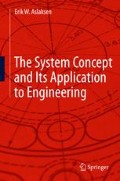Abstract
At the start of the previous chapter, we identified usefulness as a main characteristic of engineering. We all probably understand what this means in a general way, but how can we define this attribute in such a way that we can measure it? Our earlier, very general definition of usefulness as the degree to which the results of the engineering activity meets the stakeholders’ expectations is well and good, but when we consider the myriad of activities engineers are engaged in, from teaching to research, design, management, maintenance, etc, we see that the expectations can be very different in nature and therefore require very different measures. What we need to do is to apply the systems approach and, as a first step, abstract from the details of the particular activities in order to identify what they have in common. No matter what the requirements are, meeting them must have a value to the person or group of persons who raised them and, at least in principle, the common measure of value is a monetary one. The idea of putting a monetary value on the outcomes of all engineering activities is controversial, and assigning an actual numerical value to this parameter can be even more difficult, but it is in identifying and confronting these difficulties that we can hope to make some headway into developing this central characteristic of engineering.
Access this chapter
Tax calculation will be finalised at checkout
Purchases are for personal use only
Preview
Unable to display preview. Download preview PDF.
References
Warfield, J.N.: An Introduction to Systems Science. World Scientific Publishing (2006)
Project Alliancing – Practitioners’ Guide, issued by the Government of Victoria, Australia (2006)
Kiers, D.: Alliance Competence: Key Capabilities for Success. APPEA Journal, 811–822 (2001)
Target Outturn Cost: Demonstrating and Ensuring Value for Money, Alchimie Pty. Ltd. (2004), http://www.alchimie.com.au
Honour, E.C.: Understanding the Value of Systems Engineering. In: Proc. 14th Annual Internat’l Symposium, INCOSE (2004), www.incose.org
Honour, E.C.: Dissertation at the University of South Australia, Contact E.C. Honour for relevant information and material (2012), http://ehonourhcode.com
Author information
Authors and Affiliations
Corresponding author
Rights and permissions
Copyright information
© 2013 Springer-Verlag Berlin Heidelberg
About this chapter
Cite this chapter
Aslaksen, E.W. (2013). Usefulness – The Purpose of Engineering. In: The System Concept and Its Application to Engineering. Springer, Berlin, Heidelberg. https://doi.org/10.1007/978-3-642-32169-6_8
Download citation
DOI: https://doi.org/10.1007/978-3-642-32169-6_8
Publisher Name: Springer, Berlin, Heidelberg
Print ISBN: 978-3-642-32168-9
Online ISBN: 978-3-642-32169-6
eBook Packages: EngineeringEngineering (R0)

